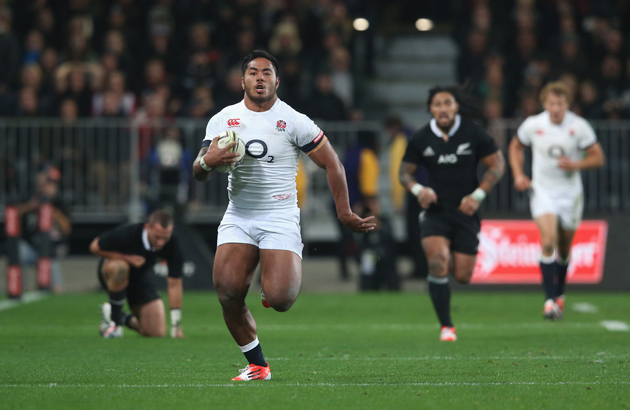Chris Robshaw's side lost by just one point in Dunedin on Saturday – but what lessons to they need to take from the defeat into this weekend's third Test?
ON THE surface, this was another step forward for intrepid England. To get within a single point of New Zealand, to match them in terms of tries scored and to do so almost 12,000 miles away from Twickenham amounts to a decent representation of where this squad sits in the global pecking order – right at the front of the chasing pack alongside South Africa.
But Tom Wood’s despondence at the end of the game spoke volumes. Despite rallying in the closing stages, he knew the tourists had not done themselves justice. This may have been the closest England have come to the All Blacks since overturning them in December 2012, but it was also the most underwhelming performance in those three subsequent losses. Richie McCaw’s boys were brilliant in patches, but they could have been beaten.
England have earned the right to be judged by world-class standards, to be hard on themselves even when they are edged out by the best. With that in mind, here are five things we learned from another enthralling Test…
Half-hour of power
Sometimes in sport you can pinpoint momentum swings. On Saturday, there were two. First, Ben Smith hunted down Manu Tuilagi for a miracle tackle and turnover. Then, shortly after half-time, an over-ambitious offload from Billy Twelvetrees burst things open.
With England leading 10-6, the Gloucester centre made a half-break and nearly freed Tom Wood up the middle, his flick instead hitting turf. Brodie Retallick picked up and carried to his own ten-metre line. Exactly six passes and 17 seconds later, the magnificent Smith dotted down under the posts.
It was a wonderful score that demonstrated New Zealand’s unparalleled ability to transition between dogged defence and devastating attack – a stunning sucker-punch. Even more impressive was how the All Blacks identified weakness and rose to their very best for the next 30 minutes, dominating every contact situation with an irresistible increase in intensity. Two more tries killed the contest and snatched the series. Steve Hansen’s men had given a lesson in world-champion ruthlessness.
Back-line confusion, not back-line cohesion
This encounter highlighted the problems of England’s tour scheduling more harshly than last week’s thriller in Auckland. New Zealand progressed with just one change to their 23, while Stuart Lancaster saw rust seep in as he tried to reintegrate his Premiership finalists.
Largely consistent selection up front – Tom Wood coming in for James Haskell the sole switch – meant Graham Rowntree’s pack initially made inroads, dominating tight exchanges from the solid base of an accurate lineout and well-organised mauling. However, a back-line containing four new faces did not fuse together.
Individual brilliance was not the problem – England made six line breaks in the opening 40 minutes. Support lines did not match up, though, meaning just ten points were scored before the break. Tuilagi should have converted his breakaway chance, but Mike Brown’s follow-up – which inexplicably ended up 20 metres away as Ben Smith made the tackle – defined the gulf in finishing prowess between the teams. When England clicked there with two consolations – but it was too late.
Calmer kicking game required
Fast and loose does not cut it when the All Blacks are in meticulous mode. England aimed for a high-tempo attacking approach, but strayed into the realms of recklessness. Game management went missing and wayward kicking was the prime culprit. With due respect to David Wilson, when a prop shows better awareness of when to clear than the half-backs, there are problems.
Lancaster urges his players to seize field position by making kicks ‘contestable’ (think well-weighted high balls and grubbers that encourage chasers). Too many of England’s 27 punts this weekend fell in a murky middle ground. Now and then, there was a suicidal reluctance to get the ball off the park as well. Danny Care over-hit a couple from the box and Owen Farrell’s efforts often fell far infield – a cardinal sin opposite Ben Smith and Julian Savea. All these mistakes contributed to a paltry return of 39% territory and 40% possession, which isn’t a foundation from which to beat the All Blacks.
Selection waters far from clear
Bar Sam Burgess, Lancaster has now seen every player in competition to feature in the 2015 World Cup and this trip has confirmed England’s outstanding strength in depth. Even so, a bigger challenge begins now – finding out the best means of channelling such quality.
The Tuilagi wing experiment must be shelved, with Chris Ashton coming in for Luther Burrell. Tuilagi and Twelvetrees should form England’s midfield this weekend. Though Geoff Parling was phenomenal in Dunedin, making 21 tackles and guiding the lineout, Courtney Lawes and Joe Launchbury have to start too – likewise Dylan Hartley and Billy Vunipola. Honing first-choice combinations ahead of next year has to be the primary goal.
Two games to save this tour
“We’re still learning, but now it’s about results.” That was Twelvetrees’s post-game take. He was spot on. In the past fortnight, England have confirmed they are capable of a bona fide tilt at the Webb Ellis Cup. This week, the developmental rawness has to be stripped away.
Victory in Canterbury on Tuesday is hugely important. Ed Slater is the perfet man to lead that effort and the side is more than strong enough. After that, Lancaster’s squad should be buoyed for one last push.
Remember, New Zealand are the first visitors to Twickenham in November. Scraping home on Saturday would give England a shot at two consecutive triumphs over the All Blacks – a simply mammoth fillip that would evaporate any deep-lying inferiority complex. This long, winding season is significant until its final whistle.








